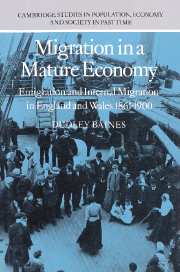Book contents
- Frontmatter
- Contents
- List of tables
- List of figures
- Acknowledgements
- 1 Introduction: the scope of the study
- 2 Issues in the history of European emigration, 1840–1914
- 3 The characteristics of British emigrants before 1914
- 4 The estimation of migration by county of birth
- 5 Return migration to Britain, 1860–1914
- 6 The birthplace of English and Welsh emigrants, 1861–1900
- 7 English and Welsh emigrants in the 1880s and 1890s
- 8 Emigration and urban growth
- 9 Rural-urban stage emigration, 1861–1900
- 10 Wales and the Atlantic economy, 1861–1914
- A summary of conclusions
- Appendices
- 1 Net migration of natives into other counties and overseas,1861-1900.
- 2 Minimum estimates of English and Welsh emigration (gross outward passenger movement), 1825–1853.
- 3 Emigration (outward passenger movement) from Scottish ports, 1825–1853.
- 4 Emigration (outward passenger movement) of natives of England and Wales, 1853–1930.
- 5 Emigration (outward passenger movement) of Scottish natives, 1853–1930.
- 6 Male and female lifetime emigrants and lifetime internal migrants from Northumberland, Durham, Cumberland and Westmorland, 1861–1900.
- 7 A model of internal and overseas migration by natives of English and Welsh counties, 1861–1900 (by Dr Mary Morgan).
- Bibliography
- Index
7 - A model of internal and overseas migration by natives of English and Welsh counties, 1861–1900 (by Dr Mary Morgan).
Published online by Cambridge University Press: 24 November 2009
- Frontmatter
- Contents
- List of tables
- List of figures
- Acknowledgements
- 1 Introduction: the scope of the study
- 2 Issues in the history of European emigration, 1840–1914
- 3 The characteristics of British emigrants before 1914
- 4 The estimation of migration by county of birth
- 5 Return migration to Britain, 1860–1914
- 6 The birthplace of English and Welsh emigrants, 1861–1900
- 7 English and Welsh emigrants in the 1880s and 1890s
- 8 Emigration and urban growth
- 9 Rural-urban stage emigration, 1861–1900
- 10 Wales and the Atlantic economy, 1861–1914
- A summary of conclusions
- Appendices
- 1 Net migration of natives into other counties and overseas,1861-1900.
- 2 Minimum estimates of English and Welsh emigration (gross outward passenger movement), 1825–1853.
- 3 Emigration (outward passenger movement) from Scottish ports, 1825–1853.
- 4 Emigration (outward passenger movement) of natives of England and Wales, 1853–1930.
- 5 Emigration (outward passenger movement) of Scottish natives, 1853–1930.
- 6 Male and female lifetime emigrants and lifetime internal migrants from Northumberland, Durham, Cumberland and Westmorland, 1861–1900.
- 7 A model of internal and overseas migration by natives of English and Welsh counties, 1861–1900 (by Dr Mary Morgan).
- Bibliography
- Index
Summary
This appendix presents an econometric analysis of the overseas and internal migration series reported in Appendix 1. It proposes a model, based on the traditional theories of economists and economic historians, that is appropriate for the explanation of domestic and overseas migration on a cross section basis. Data which incorporate both cross section and time series dimensions present particular, but well recognised, econometric problems both in modelling and in estimation. These problems are discussed in order to justify the use of covariance analysis in this instance. The results of this analysis of the data are presented and their implications discussed.
The model
Although economists' and economic historians' theories of migration tend to differ, the econometric models derived from both theories are basically similar. The economist postulates a micro-economic theory of migration which depends on the individual's reaction to opportunities at home versus opportunities in an alternative environment (either another country or another area of the same country). In this model, the individual maximises his or her welfare by migrating when the expected gains from moving (allowing for the cost of the move) outweigh the expected gains from not moving. A comparison is therefore made at each point in time between job opportunities, expected earnings, etc., which in turn depend on the supply and demand factors at work, in the two (or more) alternative labour markets.
The economic historian is concerned with explaining mass migration movements of the past and the traditional migration theory is couched in terms of push and pull factors which operate to cause these aggregate movements.
- Type
- Chapter
- Information
- Migration in a Mature EconomyEmigration and Internal Migration in England and Wales 1861–1900, pp. 308 - 337Publisher: Cambridge University PressPrint publication year: 1986



